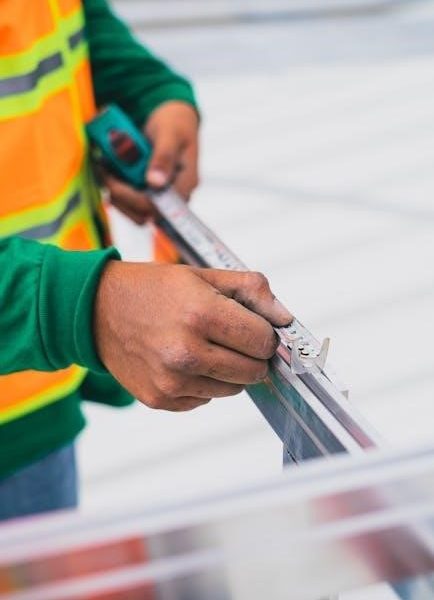Overview of the Honeywell M847D Zone Damper Actuator
The Honeywell M847D is a two-position, 24V AC spring-return damper actuator designed for ARD, EARD, and ZD zone dampers, controlling airflow in HVAC systems efficiently.
The Honeywell M847D Zone Damper Actuator is a versatile and reliable component designed to regulate airflow in HVAC systems. It operates as a two-position, 24V AC spring-return actuator, ensuring smooth and precise control of zone dampers. This actuator is specifically engineered to work with ARD, EARD, and ZD series dampers, making it a critical part of modern heating, cooling, and ventilation systems. Its spring-return mechanism guarantees a fail-safe operation, returning the damper to its default position when power is lost. Designed for both residential and commercial applications, the M847D is known for its durability and energy efficiency. With its low voltage requirements and compact design, it seamlessly integrates into various HVAC setups, providing consistent performance and reliability.
1.2 Key Features and Specifications
- The Honeywell M847D is a two-position, 24V AC spring-return damper actuator.
- Designed to operate ARD, EARD, and ZD zone dampers for precise airflow control.
- Features a low voltage, 24 Vac operation for safe and efficient performance.
- Spring-return mechanism ensures fail-safe operation, returning dampers to their default position when power is lost.
- Compatible with both residential and commercial HVAC systems.
- Directly drives zone dampers to regulate air flow in ducts.
- Compact design allows for easy installation and integration into existing systems.
- Durable construction ensures long-term reliability and performance.
These features make the M847D a reliable and efficient choice for controlling air flow in various HVAC applications.
1.3 Importance in HVAC Systems
The Honeywell M847D Zone Damper Actuator plays a critical role in HVAC systems by enabling precise control over airflow distribution. It ensures that heating, cooling, and ventilation are delivered efficiently to specific zones, improving overall system performance. By regulating air flow through dampers, the M847D helps maintain consistent temperatures, humidity levels, and air quality across different areas of a building. This capability is essential for optimizing energy usage, reducing operational costs, and enhancing comfort. The actuator’s reliability and compatibility with various damper types make it a vital component for modern HVAC systems, ensuring smooth operation and adaptability to changing environmental demands.

Installation and Setup of the M847D Actuator
The M847D actuator is installed by mounting it to compatible dampers, ensuring proper alignment and secure fastening. Wiring connections are made to the 24V AC supply, and the actuator is tested for correct operation.
2.1 Pre-Installation Requirements
Before installing the Honeywell M847D actuator, ensure compatibility with ARD, EARD, or ZD zone dampers. Verify the system’s voltage requirements, ensuring a 24V AC power supply. Inspect the damper for proper alignment and functionality. Clean the damper and surrounding area to prevent debris interference. Ensure all necessary tools, such as screwdrivers and wiring connectors, are available. Review the installation manual for specific mounting instructions and safety precautions. Confirm the actuator’s spring-return mechanism is functioning correctly. Check for any worn or damaged components on the damper or actuator that may require replacement. Ensure the system is powered down during installation to avoid electrical hazards. Proper preparation ensures a smooth and safe installation process.
2.2 Step-by-Step Installation Guide
Begin by disconnecting power to the HVAC system to ensure safe installation.
Mount the M847D actuator to the damper, aligning the coupling properly.
Secure the actuator using the provided mounting hardware.
Connect the actuator to the damper shaft, ensuring a snug fit.
Route the 24V AC wires, connecting them to the actuator terminals.
Test the actuator by applying power to ensure it opens and closes correctly.
Adjust the actuator’s alignment if necessary for smooth operation.
Reconnect power and test the HVAC system to confirm airflow control.
Ensure all connections are secure and the system operates quietly.
Refer to the manual for any model-specific adjustments or settings.
2.3 Wiring and Electrical Connections
For the Honeywell M847D, connect the 24V AC power supply to the actuator terminals, ensuring proper wiring to avoid damage. Use a 24V AC transformer and verify polarity. Connect the common (C), signal (R), and neutral (W) wires correctly. Ensure all connections are secure and insulated. Before wiring, disconnect power to the HVAC system for safety. Refer to the manual for specific terminal assignments. Test the actuator by applying power and verifying smooth operation. Avoid overloading the circuit and ensure compliance with local electrical codes. Proper wiring ensures reliable airflow control and prevents motor noise or malfunction.

Features and Benefits of the M847D
The Honeywell M847D is a two-position, 24V AC spring-return actuator designed for ARD, EARD, and ZD dampers. It offers efficient airflow control, reliable operation, and a spring-return mechanism for consistent performance in HVAC systems, making it ideal for both residential and commercial applications.
3.1 Voltage and Power Requirements
The Honeywell M847D Zone Damper Actuator operates on a 24V AC power supply, ensuring compatibility with most HVAC systems. Its low voltage design enhances safety and efficiency, making it suitable for residential and commercial applications. The actuator requires minimal power to function, optimizing energy consumption while maintaining reliable performance. This voltage specification aligns with standard HVAC control systems, allowing seamless integration without additional power adapters or transformers. The M847D is designed to work efficiently within its voltage range, providing consistent operation and precise airflow control in zoning systems. Its power requirements are straightforward, making it a cost-effective solution for modern HVAC setups. Always ensure the power supply matches the specified 24V AC to maintain optimal functionality and longevity.
3.2 Spring-Return Mechanism
The Honeywell M847D features a spring-return mechanism, ensuring the damper returns to its default position when power is disconnected. This mechanism is crucial for maintaining consistent airflow and system performance. It provides a fail-safe operation, automatically returning the damper to a predetermined position, typically closed, to prevent uncontrolled air circulation. The spring-return design enhances reliability and energy efficiency, as it eliminates the need for continuous power to maintain the damper’s position. This feature is particularly beneficial in HVAC systems, where precise airflow control is essential. The mechanism operates smoothly, ensuring quiet and efficient transitions between damper states. Its robust construction guarantees long-term durability, making it a reliable choice for residential and commercial zoning applications.
3.3 Compatibility with Zone Dampers

The Honeywell M847D actuator is specifically designed to work seamlessly with ARD, EARD, and ZD zone dampers, ensuring precise airflow control in HVAC systems. Its compatibility with these dampers allows for efficient regulation of air distribution, making it suitable for both residential and commercial applications. The actuator’s design enables direct operation of zone dampers, providing reliable performance and consistent system operation. By integrating with these dampers, the M847D supports advanced zoning capabilities, allowing for customized temperature control across different areas. This compatibility ensures that the actuator can be easily installed and configured with existing zone damper systems, enhancing overall HVAC efficiency and user comfort. The M847D’s universal design makes it a versatile solution for various zoning requirements.

Applications of the M847D Actuator
The Honeywell M847D actuator is primarily used in HVAC systems to control airflow, suitable for both residential and commercial applications, ensuring efficient zone temperature regulation.
4.1 Residential HVAC Systems
The Honeywell M847D actuator is widely used in residential HVAC systems to enhance zoned heating and cooling. By controlling airflow through zone dampers, it allows for precise temperature regulation in different areas of a home. This ensures optimal comfort and energy efficiency, as heating or cooling is directed only where needed. The actuator’s compatibility with ARD, EARD, and ZD dampers makes it a versatile solution for various residential setups. Its spring-return mechanism guarantees reliable operation, returning dampers to their default position when power is off. This feature is particularly useful in residential systems where consistent airflow control is essential. The M847D is ideal for single-family homes, apartments, and other small-scale applications, providing quiet and efficient performance.
4.2 Commercial HVAC Systems
The Honeywell M847D actuator is also ideal for commercial HVAC systems, offering precise airflow control in larger, zoned environments. Its compatibility with ARD, EARD, and ZD dampers ensures efficient management of heating and cooling across various zones. The actuator’s spring-return mechanism guarantees reliable operation, returning dampers to their default position when power is off. This feature is particularly beneficial in commercial settings where consistent airflow control is crucial. The M847D contributes to energy efficiency by directing airflow only where needed, reducing overall energy consumption. Its quiet operation makes it suitable for commercial spaces like offices and retail areas. Additionally, the actuator’s versatility and compatibility with different damper types make it a reliable choice for diverse commercial HVAC applications.
4.3 Use with Specific Damper Types
The Honeywell M847D actuator is specifically designed to work seamlessly with ARD, EARD, and ZD zone dampers, ensuring precise airflow control in HVAC systems. Its universal compatibility allows it to be mounted directly to these dampers, providing efficient operation and consistent performance. The actuator’s spring-return mechanism ensures dampers return to their default position when power is off, which is especially useful for maintaining proper airflow in zoned systems. This feature enhances energy efficiency and system reliability. The M847D’s design makes it a versatile choice for various damper types, ensuring smooth integration into both residential and commercial HVAC setups. Its compatibility and performance make it a reliable solution for controlling airflow in diverse applications.

Troubleshooting Common Issues
This section covers diagnosing and resolving common issues with the Honeywell M847D, such as power problems, damper alignment, and electrical connections, ensuring optimal performance.
5.1 Damper Not Responding
If the damper fails to respond, first check the 24V AC power supply to the actuator. Ensure all electrical connections are secure and not corroded. Verify that the actuator is properly wired according to the manual. If power is present, inspect for mechanical obstructions or excessive friction in the damper linkage. Check for faulty end switches or a malfunctioning spring-return mechanism. Test the actuator by manually activating it to confirm proper operation. If issues persist, replace worn or damaged components. Ensure compatibility with the zone damper type (ARD, EARD, or ZD). Consult the Honeywell M847D manual for detailed troubleshooting steps and wiring diagrams to resolve the issue effectively.
5.2 Incorrect Positioning of Damper
If the damper is not positioning correctly, check the calibration of the actuator and ensure the damper is properly aligned with the ductwork. Verify that the actuator is receiving the correct control signals from the HVAC system. If the damper oscillates or fails to reach the desired position, inspect the spring-return mechanism for proper tension. Ensure the actuator is compatible with the zone damper type (ARD, EARD, or ZD) and that all electrical connections are secure. If the issue persists, consult the Honeywell M847D manual for calibration procedures or consider replacing faulty components such as end switches or the actuator itself. Proper alignment and wiring are crucial for accurate damper positioning and system performance.
5.3 Motor Noise or Malfunction
If the motor produces unusual noise or malfunctions, inspect for worn or loose internal components. Ensure the actuator is properly lubricated and free from debris. Verify that the damper is not obstructed and operates smoothly within the duct system. Check the electrical connections for secure wiring and correct voltage supply (24V AC). If the issue persists, replace the faulty motor or actuator. Always refer to the Honeywell M847D manual for specific troubleshooting steps and replacement procedures. Regular maintenance, such as cleaning and lubricating moving parts, can prevent motor noise and ensure optimal performance. Addressing malfunctions promptly helps maintain HVAC system efficiency and reliability.

Maintenance and Care
Regular maintenance ensures optimal performance of the Honeywell M847D. Clean the actuator and damper annually, lubricate moving parts, and inspect for wear. Replace components as needed.
6.1 Regular Cleaning and Inspection
Regular cleaning and inspection of the Honeywell M847D actuator are essential for maintaining optimal performance. Turn off power to the system before starting maintenance.
Use a soft brush or cloth to remove dust and debris from the actuator and damper surfaces. Inspect for signs of wear, corrosion, or damage to moving parts.
Check electrical connections for tightness and integrity. Ensure the spring-return mechanism is functioning correctly by observing its movement.
Clean or replace filters in the HVAC system to prevent contamination. Schedule inspections annually or more frequently in dusty environments.
Proper maintenance ensures smooth operation, prevents premature wear, and extends the lifespan of the actuator and damper system.
6.2 Lubrication of Moving Parts
Lubrication of the Honeywell M847D actuator’s moving parts is crucial for ensuring smooth operation and preventing mechanical wear. Use a high-quality, silicone-based lubricant specifically designed for HVAC components.
Apply a small amount to the hinges, linkages, and gear assemblies. Avoid over-lubrication, as excess can attract dust and dirt, potentially causing malfunctions.
Lubricate every 6 to 12 months or when unusual noise or resistance is detected. Always power down the system before performing maintenance.
Proper lubrication extends the lifespan of the actuator and ensures consistent performance in controlling zone dampers.
Refer to the user manual for specific lubricant recommendations and application guidelines.

6.3 Replacing Worn Components
Regularly inspect the Honeywell M847D actuator for worn components, such as gears, hinges, or seals, which can affect performance over time. Replace these parts promptly to maintain optimal functionality. Always refer to the user manual for specific instructions and diagrams to ensure proper replacement procedures. Power down the system before starting any maintenance to avoid electrical hazards. Use only genuine Honeywell replacement parts to guarantee compatibility and durability. If unsure about the process, consult a licensed HVAC technician. Proper replacement of worn components ensures smooth damper operation, preventing airflow issues and maintaining efficient HVAC system performance. Regular inspections and timely replacements are key to extending the actuator’s lifespan.

Additional Resources and Support

Access the Honeywell M847D user manual, technical specifications, and diagrams for detailed guidance. Contact customer support via phone, email, or visit the FAQ section online.
7.1 User Manual and Documentation
The Honeywell M847D user manual provides comprehensive installation, operation, and troubleshooting guidelines. It includes detailed diagrams, technical specifications, and wiring instructions. The manual ensures proper setup and maintenance of the actuator, optimizing its performance in HVAC systems. Users can access it via Honeywell’s official website or through authorized distributors. Additional documentation, such as product datasheets and compatibility charts, is also available to facilitate seamless integration with zone dampers. For further assistance, customers can contact Honeywell’s customer support team directly for personalized guidance and solutions.
7.2 Technical Specifications and Diagrams
The Honeywell M847D technical specifications outline its operation as a 24V AC, two-position, spring-return actuator. It is designed for compatibility with ARD, EARD, and ZD zone dampers, ensuring precise airflow control in HVAC systems. Detailed diagrams illustrate wiring configurations, mechanical connections, and installation layouts. These resources are essential for understanding the actuator’s low-voltage operation and its role in maintaining efficient system performance. The diagrams also highlight the actuator’s compact design and integration capabilities, making it suitable for various zoning applications. By referencing these technical documents, users can ensure proper installation and troubleshooting, optimizing the actuator’s functionality in their specific HVAC setup.
7.3 Customer Support and FAQs
Honeywell provides comprehensive customer support for the M847D zone damper actuator, ensuring users have access to assistance when needed. The official website offers detailed FAQs, addressing common queries about installation, troubleshooting, and maintenance. Dedicated support channels, including phone and email, are available for technical inquiries. Additionally, Honeywell’s online resources include manuals, diagrams, and repair guides, helping users resolve issues independently. FAQs cover topics like actuator calibration, wiring, and compatibility with specific damper types. This robust support system ensures optimal performance and extends the lifespan of the M847D, making it a reliable choice for HVAC applications. By leveraging these resources, users can efficiently address challenges and maintain their systems effectively.


